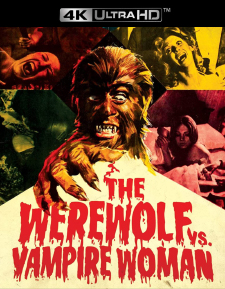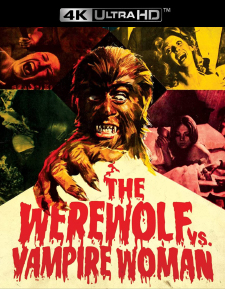Werewolf vs. the Vampire Woman, The (4K UHD Review)

Director
León KlimovskyRelease Date(s)
1971 (November 29, 2022)Studio(s)
Plata Films S.A./HIFI Stereo 70 Kg (Vinegar Syndrome)- Film/Program Grade: B+
- Video Grade: A-
- Audio Grade: B
- Extras Grade: A-
Review
Spanish actor Paul Naschy may not be as widely recognized in pop culture as other horror icons like Boris Karloff, Bela Lugosi, or Vincent Price, but for fans of the genre, he’s every bit as legendary. Unlike most of his more famous peers, Naschy was no mere actor for hire, but instead was the key creative force on most of his projects. He served not just as the lead actor for his films, but also as a writer and sometime as director, too. Yet even the films on which he collaborated with other directors still bear his own unique creative stamp. Naschy’s love of cinema was born out of his love for the classic Universal monster films, and they were profoundly influential in his own work as a filmmaker. That’s most readily apparent in the character with which he would become indelibly associated: Waldemar Daninsky, a Polish Count who happens to suffer from lycanthropy. Naschy played Daninsky in twelve different films, making him the most prolific werewolf actor of all time, besting even the great Lon Chaney, Jr.
The awkwardly titled The Werewolf vs. the Vampire Woman (aka La Noche de Walpurgis, or Werewolf Shadow) was the fifth of his El Hombre Lobo films. The English-language titles of many of Naschy’s films sometimes had little to do with the actual stories involved—for instance, Frankenstein’s Bloody Terror (aka La Marca del Hombre Lobo) has nothing whatsoever to do with either Mary Shelley’s mad scientist or his misnamed monster. In this case, however, The Werewolf vs. the Vampire Woman is at least accurate, even if it lacks the elegance of the original Spanish title La Noche de Walpurgis. Still, Walpurgisnacht isn’t necessarily familiar to most Western audiences, so the English-language distributors can be forgiven for cutting directly to the chase here, as this story does indeed feature Naschy’s werewolf at odds with a female vampire. While the films in the El Hombre Lobo series were only very loosely connected, this one is more or less a direct sequel to The Fury of the Wolfman (aka La Furia del Hombre Lobo), opening with Daninsky lying dead from the silver bullet that felled him in that film. You can’t keep a good werewolf down, so that problem is quickly solved, and the rest of the story never looks back. Despite that otherwise unexplained connection to the previous film, The Vampire vs. the Werewolf Woman stands well enough on its own, and doesn’t really suffer if you have a lack of familiarity with the rest of the series.
That’s due in no small part to Naschy himself. Thanks to his charismatic performance, Waldemar Daninsky springs to vivid life here, in more ways than one. Daninsky is the werewolf as antihero, a tortured soul much like the brooding vampire Lestat in Anne Rice’s later series of novels. Naschy’s intense presence as Daninsky is the glue that holds all of the El Hombre Lobo films together, regardless of the actual stories that were involved—or the directors, for that matter. Yet The Werewolf vs. the Vampire Woman was still aided immeasurably by the presence of Argentinian filmmaker León Klimovsky behind the camera. Klimovsky provided a beautiful sense of atmosphere for the film, making an effective use of lighting and slow motion to create an unearthly sense of presence for the vampires. A brooding werewolf needs an equally brooding world to inhabit, and Klimovsky delivered that environment in spades. Still, it’s unquestionably Naschy who was the driving force behind the film, and The Werewolf vs. the Vampire Woman remains a testament to his love of the cinema. If you’ve never seen any of Naschy’s films, this a great starting place to rectify that situation.
Like many vintage genre films that were prepared with the international market in mind, The Werewolf vs. the Vampire Woman exists in different versions with different running times. Censorship under the Franco regime meant that nudity was frowned upon, as was excessive violence or gore. As a result, the Spanish version used alternate takes for the nude scenes from the international version, and trimmed some of the blood and guts as well. On the other hand, it also included a few moments of dialogue that weren’t in the international cut. The “nude” international version runs 87:03, while the “clothed” Spanish cut runs 93:49. There’s also a hybrid “integral” version, running 94:37, that edits the nude scenes back into the longer Spanish version. It’s not an official version of the film, but it’s one that has been widely available on home video over the years. (The original U.S. theatrical version ran approximately 82 minutes, but that hasn’t been included here.)
The international version is the one that conforms to the original 35 mm camera negative, so that’s what was used for this restoration. The negative was scanned at 4K resolution, cleaned up, and then graded for HDR (only HDR10 is included on the disc). The resulting 1.85:1 image does justice to Leopoldo Villaseñor’s moody cinematography, with only one possible issue—more on that in a moment. The opening titles and any other optical work naturally look a bit softer and grainier, but the rest of the film is sharp and detailed, with an even sheen of grain. Facial textures, clothing, and environmental details are all well-resolved. There’s not much in the way of damage, aside from some fleeting scratches, speckles, and also a few blemishes along the edges of the screen. The colors are nicely saturated, with natural looking flesh tones, and the contrast range is solid, with nice black levels.
In the spirit of full disclosure, I must point out that I experienced issues with the HDR layer when I watched the disc for the first time. It was a weird pulsing effect that caused rhythmic smearing of detail and color/contrast shifts, most notably in the dialogue scene starting at 12:57, and in a few other places as well. However, I haven’t been able to replicate the same issue since then, so it may indeed have been something related to my player/display combo (an Oppo UDP-205 feeding a JVC RS2000), rather than anything to do with the disc itself. Searching various home theatre forums hasn’t turned up any examples of people having the same issue, and the problem didn’t occur when I replayed the disc. Still, that’s never happened with any other disc in my system, before or since. So, I want to point out that it did happen, but also to make it clear that as of this writing, no one else has reported the same problem. It seems safe to say that you won’t experience the same thing.
(Note that the “clothed” and “integral” versions included here appear to have been derived from the same 4K restoration of the international cut, with the alternate material being supplied from dupe sources that aren’t in quite as good condition as the primary elements.)
Audio is offered in Spanish 2.0 mono DTS-HD Master Audio and English 2.0 DTS-HD Master Audio. There are three distinctly different subtitle options: English SDH for the English dub, original Spanish-to-English, and Spanish-to-English SDH. Everything sounds clean and clear, with no noteworthy noise, distortion, or other artifacts. Like many foreign films produced during that era, the dialogue was largely post-synced, with the actors speaking their native languages on set, and everyone dubbed later. As a result, the choice between Spanish and English will come down to personal preference—there’s no clear winner between the two.
Vinegar Syndrome’s 4K Ultra HD release for The Werewolf vs. the Vampire Woman is a three-disc set that includes one UHD and two Blu-rays. The insert is reversible, with different theatrical poster artwork on each side, and there’s also a Limited Edition embossed slipcover that’s available directly from Vinegar Syndrome, designed by Earl Kessler, Jr., which is limited to the first 5000 units. The UHD and the first Blu-ray both feature the 87-minute international version of the film, with all of the extras confined to that Blu-ray. The second Blu-ray offers both the “clothed” and the “Integral” cuts, with no extras. The following extras are included on the first Blu-ray only, all in HD:
- The Man Who Saw Frankenstein Cry (80:28)
- Interview with Sergio Molina (29:04)
- The Werewolf vs. the Vampire Woman Trailer (1:03)
- Werewolf Shadow Trailer (3:14)
- Alternate Title and End Credit Sequences (7:17)
- Still Gallery (1:46)
There’s not a lot of extras here, at least in terms of quantity, but whatever they may lack in breadth, they more than make up for it in terms of depth. The crown jewel of the set is The Man Who Saw Frankenstein Cry, which is feature-length documentary about Naschy. Written and directed by Ángel Agudo, it’s a comprehensive look at the Spanish Lon Chaney, featuring interviews with John Landis, Joe Dante, Mick Garris, and Caroline Munro, as well as friends, family, and coworkers of the legendary horror icon. Garris serves as host, guiding viewers through an exploration of Naschy’s life and works, from the challenges of his childhood in Franco’s Spain during the Spanish Civil War, to the cultural legacy that he left behind him. It examines his collaborations with directors like León Klimovsky and Carlos Aured, as well as his own work behind the camera (credited under his given name Jacinto Molina). Naschy had a great love for the cinema, and it’s evident here how much everyone with whom he had contact loved him back. There’s a great circularity in genre filmmaking, with previous generations of filmmakers inspiring new ones, and Naschy was no exception. The first film that he saw was Frankenstein Meets the Wolf Man, and Dante points out how that formed the basis for the ethos of the kinds of pictures that he would end up making. Needless to say, Naschy’s own films have been inspirations for the generations that have followed. (Note that The Man Who Saw Frankenstein Cry is in both Spanish and English, with non-removable English subtitles for the former, and Spanish subtitles for the latter.)
The new interview is with Paul Naschy’s son Sergio Molina, who shares his own love for his father. He affirms that the cinema was indeed Naschy’s life, but says that he feels that the filmmaker was never really understood in his native Spain. Molina spends some time considering Naschy’s place in the Spanish film industry, as well as his position under Franco, and also breaks down some of his father’s films. There’s a natural emphasis on The Werewolf vs. the Vampire Woman, which he considers to be a fundamental film in Naschy’s career. The Alternate Title and End Credits Sequences is a compilation of the titles from the German, U.S., and U.K. releases. Finally, the Still Gallery includes promotional materials, behind-the-scenes photographs, and scans of some articles related to the film.
There were some extras on the 2014 Blu-ray from Subkultur Entertainment in Germany that aren’t included here: a brief interview with Naschy, another with Gabby Fuchs, and the German Super-8 digest version of the film. However, Subkultur’s edition didn’t include The Man Who Saw Frankenstein Cry, and of course it didn’t have the new interview with Molina, either. From a value-added perspective, this Vinegar Syndrome release trumps all previous versions—to say nothing of the fact that it offers a lovely new 4K restoration. The Werewolf vs. the Vampire Woman is an essential film for Naschy, fans, and it’s a solid entry point for anyone else who wants to discover the Spanish Lon Chaney for themselves.
- Stephen Bjork
(You can follow Stephen on social media at these links: Twitter and Facebook.)

